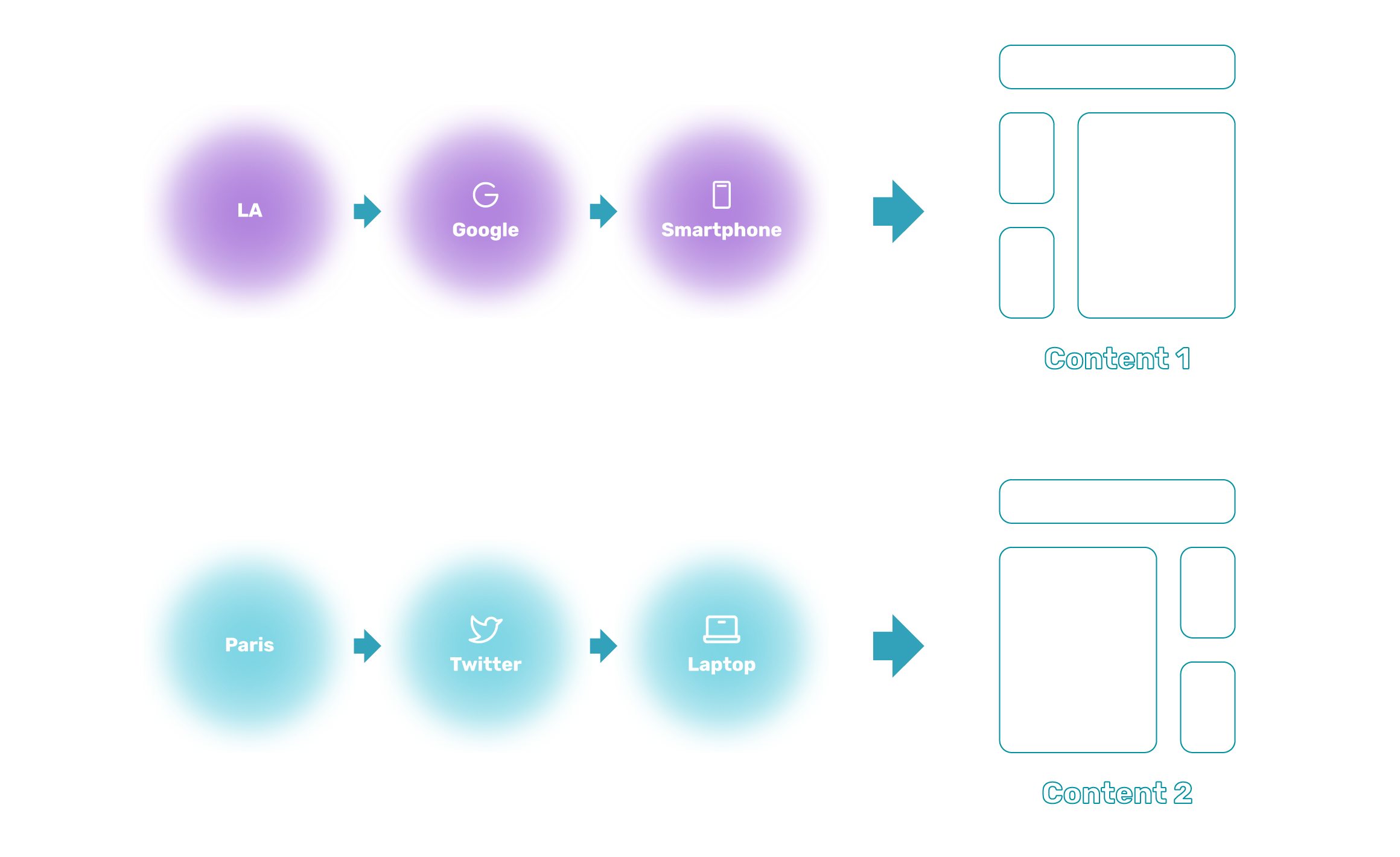- What we do
- Services
- Solutions
- Our Works
- Company
- Contact Us
February 26, 2021
Contentful and Content Personalization: Why Flexible Content Model Matters
It’s no secret that everyone likes hearing their name, whether it’s a conversation with a close friend, in small talk with a colleague, or a weekly newsletter from a favorite grocery store. Personalized content on your website can do an excellent job for your marketing and sales. Let’s dive into the topic of how to personalize with Contentful.
Today’s business environment is more competitive than ever. It’s not enough anymore to just have an outside banner or send a daily newsletter. The audience is sick with similar advertisements and calls to action. Nowadays marketing requires a far more creative and diplomatic approach, and that is why personalization is a must-have for well-built marketing.
Personalization is a process of tailoring the content for various segments of the target audience. It’s based on the available data that customers allow analytics services to collect, such as:
- Gender
- Age
- Location
- Time
- Visitor frequency
- Device
- Session behavior
Tailored content will become a huge competitive advantage to all your marketing channels and build brand awareness. But what exactly does it do for your brand’s goodwill? And how does Contentful address that challenge?
Why personalization is important
There are several reasons for a business to create personalized content:
You will get closer to your customers
Your existing and potential customers come to your website for different reasons. Some customers come to you for the first time to look through your catalog of goods or services, some of them return to buy a particular item, some want to compare your offerings to your competitors. Besides, all customers have their own traits that can influence their buying decisions, like age or location.
Here is the problem: a lot of websites and landing pages show the same content to all of the customers. They don’t take into account where potential customers come from or what they want from the business right now. Since all visitors see the same content, it’s inevitable that it will be fitting for some while others find it useless.
Content personalization addresses the issue of multiple segments in the target audience. Depending on all the characteristics mentioned above, the website will display the most relevant information that will cater to their individual needs.
If we want to visualize the flow, it will look like this:

Emotional attachment makes a point here. Personal interaction is something that brands use extremely actively today, and it helps them build stronger and more engaging relationships with their customers. People like to buy from companies that know their name, purchase history, and as a result, deliver useful content. For a seamless integration of personalized content, you need a way to add and manage user information to share the relevant information and experience at the right time with the right audience segment.
You will build your brand voice
You will also want to provide your company with personal information to provide a unique marketing experience. This includes the personal aspect of your work.
The email services have an automated solution for asking authors to send responses. In particular, check the suitability of the company in the picture, followed by the names of your employees and the employees themselves. This lets the customer know that they’re interacting with a real company, not just automated bots.
Today, many companies combine company names with department heads to provide customers with a friendly experience.
You will encourage sales
This benefit stems directly from the previous two. The customers will appreciate personalized recommendations and guidelines. That will help your customers understand that you are ready to solve their pain points and truly care about their needs, which will result in higher brand loyalty and increasing profit.
Is “insert a name” enough?
Well, no, it’s not. Simple name changing in a pre-made template hardly works in today’s environment. In addition to this, an extremely useful personalization tool that you can use is web personalization.
An important note: don’t confuse web personalization with dynamic content personalization. Dynamic content is about data-driven segmentation of the target audience and displaying the relevant content to the appropriate segments. That applies to personalized emails or ads: you just show customers something that they would like according to gender, location, or age.
We can face a problem at this stage: if a person clicks on a relevant advertisement but lands on a static web page with one-for-all content, they may become disappointed, and you will miss an opportunity to get a loyal client.

Here is where web personalization comes into play. Web personalization is a process of changing the website in real-time, taking into account the customers’ past interactions and interests.
As a result, when a potential customer clicks on the personalized ad, they can access online services that meet their needs and are managed through a conversion tool.

How Contentful deals with content personalization
Contentful is a headless CMS, which uses content models for creating and managing website content. Using this CMS for your website can give you a huge advantage in terms of a personalized approach to content marketing.
The traditional content management systems are made for websites, and many of them organize the content within the limits of a central structure where all elements of a web page (headlines, images, summaries, calls to action) are blended with the part of the code that creates a specific layout. Since the content is strongly connected with code, each channel requires a different CMS, which limits reusing opportunities of your personalization strategy.
Content must be adapted for use on all channels to meet the general needs of today's customers. In Contentful, personalization begins with a content model that breaks down your content into separate parts, such as the title or an image block. You decide what you need for that model and how those parts are related to each other. This way, you can create an easy-to-use content infrastructure framework that manages content for omnichannel use. Additionally, you can easily differentiate elements for audience segments, devices, or special characteristics, which automates personalization.
For example, a traditional landing page content model can contain several fields: title, text, author, form for subscribing to a newsletter. When the model is flexible, like in Contentful, those fields can be reorganized depending on the channel or, with the help of integrated third-party tools, create the most relevant pages for each user. With a functional content template, we can create a custom page for specific target audiences.
Content personalization strategy with Contentful
Here we share some tips that will help you use Contentful to build the most effective content personalization strategy for your business.
Firstly, data. Data is a true personalization currency. To successfully apply a personalization strategy, you first need to know what your customers are used to, like, and do. It can be hard to understand when and where to use proper personalized content if you don't have full knowledge of the customer journey.
Taking into account that you need a considerable amount of customer-related data, the investment into tools for collecting data seems like a reasonable step. Contentful has an advantage here since it’s a scalable and customizable platform. You can integrate any tool or service that will help you gather user data.
The better you listen to what your customers give you, the more successful your personalization strategy will be. All the time your users try to communicate with your business in a variety of ways. They tell you their interests, activities, location, favorite media, and what they do when they get to your website. Your primary task is to convert all this into data, divide the target audience by similar behavior patterns, specify their needs, and make changes in your content according to that data.
An important note: focus. The customer journey starts working only if you use the most relevant data about each audience segment for personalization strategy. Instead of putting everything you know about your customers into work at once, a well-built strategy will help you focus on smaller goals that are easier to achieve. It’s good to start with something helpful for your customers, for example, account browsing history.
Secondly, a flexible content model. This is the key to getting the most out of your content personalization strategy. The flexible multi-channel content model solves existing content problems and tedious editing tasks. You can quickly adapt your content to customer demand, such as expanding to new channels, finding your audience in new markets, or introducing new content formats.
In addition, Contentful can easily integrate with your existing tech stack. It simplifies content activities with tools like personalization, analysis, and automation across all content channels.
Thirdly, speed. When it comes to personalization, speed can be defined as your ability to create relevant content with understandable messages, edit and optimize it, and finally distribute it through all devices and channels at the right time. Contentful helps you broaden the abilities of the creative team by collecting content in a single hub, facilitating distribution, and reducing small monotonous tasks like adjusting the content for various platforms.
If you want your message to be displayed for the right customer, you should adapt to today’s omnichannel marketing world. Since it can be difficult for marketing specialists and content editors to switch between CMSs responsible for different channels, you need a platform that addresses every possible way of communication with your customers, and Contentful is the right choice. It keeps everything in one place and helps you stay within your brand’s voice and avoid conflicting content.
Lastly, different markets. If you want to receive the highest possible revenue, you should be able to scale up your content to different markets. Do you want to integrate a new channel? Your website should be able to deliver content to any digital platform. Do you go international? You will definitely need to translate the content on your website, taking into account all cultural differences.
Back-end content editing allows you to save your brand labels in all the channels and deliver the right content to the right audience at the right time to get the best possible feedback and grow brand loyalty.
Other advantages of Contentful for building personalized marketing include:
- RESTful API
- A user-friendly interface (no technical knowledge, no problem!)
- Instructions for every field type, so editors can easily add content
- Content structuring flexibility
Conclusion
Regardless of the industry your business belongs to, everyone likes to hear their names mentioned on a website. If the website perfectly reflects their needs or answers their urgent question, the business gets additional loyalty points and attracts new customers. This is hard to achieve without content personalization.
Taking into account the modern multi-channel environment, the content should be adapted to as many platforms as possible. With the help of a flexible content model, you can hit the target audience accurately, and that is why Contentful is your way to a successful omnichannel content strategy.
We are ready to help you build your Contentful-based website.
Get in touchGot a project in mind?
Fill in this form or send us an e-mail
Subscribe to new posts.
Get weekly updates on the newest design stories, case studies and tips right in your mailbox.
